Side Menu:
Sixth Officer James Moody
- Titanic
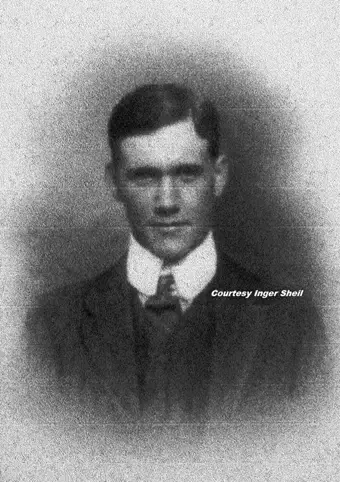
Undated photograph of James Moody
(source: Inger Sheil). (Click to enlarge)
In 1912, 24 year old James Moody, while in New York aboard the Boadicea in 1904, made a friend of a benefactor, a Mr. Selby, who he described as a 'Yankee friend.' They afterwards met in New York and London. Selby wanted Moody to visit Paris with him in March 1912. Moody applied to the White Star Line for leave to do so, but his request was denied; he was wanted aboard the White Star Line's newest addition: Titanic. Moody wrote: "‘We can’t have big ships and holidays!’" (1904 - 1912 correspondence of James Paul Moody.)
In March 1912 he received word that he was to be assigned to RMS Titanic as her Sixth Officer. As Sixth Officer he received no rise in pay or rank (he was paid £8.10 a month). At 9 a.m. on the 26th of March 1912 Moody and the other junior officers of the Titanic - Third Officer Herbert Pitman, Fourth officer Joseph Boxhall and Fifth Officer Harold Lowe - collected tickets from the White Star Line marine superintendent in Liverpool for their journey to Belfast. They departed from Liverpool at around 10 pm that night arriving in Belfast sometime around 10.00 am on March 27. At noon they reported to Chief Officer William Murdoch aboard the Titanic.
On the 30th of March he sent a postcard from Belfast to his auntie in which he described his "present floating home nearly ready for sea...have been ere a week now, chiefly occupied trying to find my way about the big omnibus."
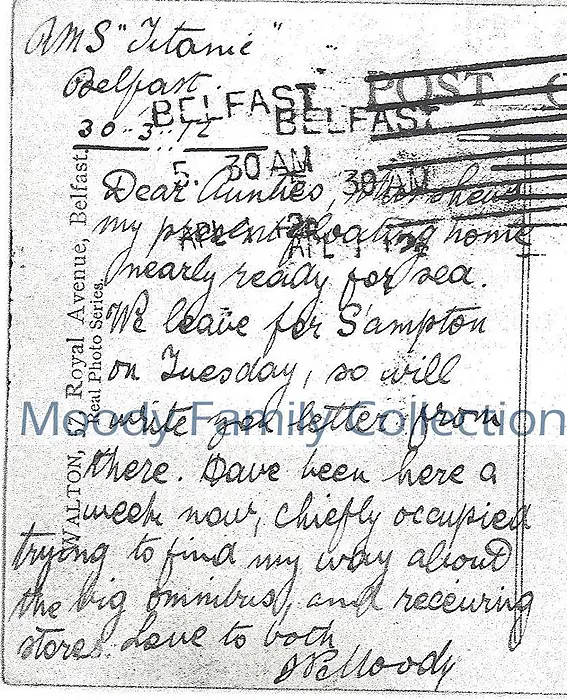
Postcard written by James Moody dated 30th of March 1912 in which describes Titanic as a "big omnibus." (Inger Sheil/Moody family collection). (Click to enlarge)
No doubt Moody was proud to have been assigned to the largest and most prestigious ship ever built - it dwarfed the Oceanic. Moody later wrote to his sister Margaret about the size of the ship -"have been here a week, chiefly occupied trying to find my way about the big omnibus." He also noted that the "Titanic, Olympic and Oceanic are going to be the 3 White Star ships on the S'ton - New York route for at least all summer, unless of course any unforeseen diversion turns up." Moody's impression of the size of the ship is also seen when he writes: "I cannot describe any part of a ship which needs 85 clocks and 16 pianos to furnish it!" After arriving he wrote that the junior officers "just played about the ship, learning the best way to get from one end to the other which I assure takes quite a bit of finding."(J.P. Moody letter to Margaret Moody, 4 April 1912)
Of his new captain, Edward "E.J." Smith, he observed, "Though I believe he's an awful stickler for discipline, he's popular with everybody". He then references Captain Haddock of the Olympic - "Daddy Haddock' is going to the Olympic until old 'E.J.' retires on his old age pension from the Titanic..." However, not all was large and prestigious. He wrote to his sister: “My room is no bigger than a broom cupboard.” (Bridge Duty, Officers of the RMS Titanic, Inger Sheil & Kerri Sundberg 1999)

Sixth Officer Moody's cabin highlighted within Titanic's officer's quarters.
He described it as "no bigger than a broom cupboard" (Encyclopedia Titanica)
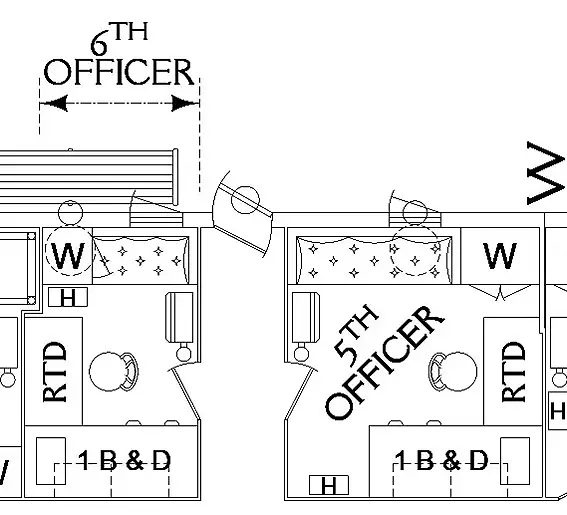
A close up of the "broom cupboard" (Titanic: Honor and Glory)
In his role as sixth officer he was responsible for two, four-hour watches each day.
As a junior officer he shared his watches with Fourth officer Joseph Boxhall. This included "dog watches" a shift in a maritime watch system that is half the length of a standard watch period which is formed by splitting a single four-hour watch period between 16:00 and 20:00 (4 pm and 8 pm) to form two two-hour dog watches, with the "first" dog watch from 16:00 to 18:00 (4 pm to 6 pm) and the "second" or "last" dog watch from 18:00 to 20:00 (6 pm to 8 pm). The logic behind this is to rotate the watches by creating an odd number of watches in a ship's day and hence avoid the same men being assigned the mid-watch (midnight to 4 am) every night.
Aboard Titanic in practice this meant:
|
Regular Sea Watches |
|
|
First watch |
8pm - Midnight |
|
Middle watch |
Midnight - 4am |
|
Morning watch |
4am - 8am |
|
Forenoon watch |
8am - Noon |
|
Afternoon watch |
Noon - 4pm |
|
First Dog Watch |
4pm - 6pm |
|
Second Dog Watch |
6pm - 8pm |
|
Senior Officer of the Watch |
||
|
Chief Officer Henry Wilde |
2am - 6am |
2pm - 6pm |
|
2nd officer Charles Lightoller |
6am - 10am |
6pm - 10pm |
|
1st officer William Murdoch |
10am - 2pm |
10pm - 2am |
Because of the "Dog Watches", the Junior Officer's watches rotated every two days:
|
Junior Officers - Day 1 |
|
|
4th Officer Boxhall & 6th Officer Moody |
12am - 4am |
|
3rd Officer Pitman & 5th Officer Lowe |
4am - 8am |
|
4th Officer Boxhall & 6th Officer Moody |
8am - 12pm |
|
3rd Officer Pitman & 5th Officer Lowe |
12pm - 4pm |
|
4th Officer Boxhall & 6th Officer Moody |
4pm - 6pm (First Dog Watch) |
|
3rd Officer Pitman & 5th Officer Lowe |
6pm - 8pm (Second Dog Watch) |
|
4th Officer Boxhall & 6th Officer Moody |
8pm - 12am |
|
Junior Officers - Day 2 |
|
|
3rd Officer Pitman & 5th Officer Lowe |
12am - 4am |
|
4th Officer Boxhall & 6th Officer Moody |
4am - 8am |
|
3rd Officer Pitman & 5th Officer Lowe |
8am - 12pm |
|
4th Officer Boxhall & 6th Officer Moody |
12pm - 4pm |
|
3rd Officer Pitman & 5th Officer Lowe |
4pm - 6pm (First Dog Watch) |
|
4th Officer Boxhall & 6th Officer Moody |
6pm - 8pm (Second Dog Watch) |
|
3rd Officer Pitman & 5th Officer Lowe |
8pm - 12am |
Belfast Sea Trials
After a day's delay due to bad weather, Titanic's sea trials commenced in Belfast Lough on April 2nd, 1912. "Moody and Murdoch played a role in the "stopping test", conducted after lunch. A buoy was dropped, which the ship then approached at full speed while the Chief and Sixth Officers observed it with their sextants. Titanic took approximately 850 yards to come to a complete stop." (Bridge Duty, Officers of the RMS Titanic, Inger Sheil & Kerri Sundberg 1999)
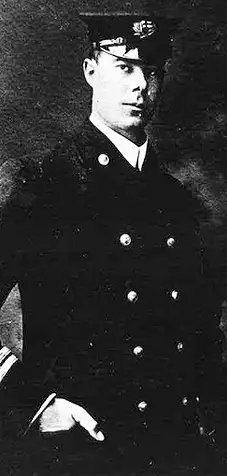
Lowe remembers overhauling
the starboard lifeboats with Moody
in Belfast.
Moody was also involved in testing the lifeboats. According to later testimony by Fifth officer Lowe, Pitman and Boxhall took the port side boats while Lowe and Moody took the starboard boats:
Fifth officer Lowe: "We overhauled them; that is to say, we counted the oars, the rowlocks, or the thole pins, whichever you like to call them, and saw there was a mast and sail, rigging, gear, and everything else that fitted in the boats, and plugs, and also that the biscuit tank was all right, and that there were two breakers in the boat, two bailers, two plugs, and the steering rowlock; that is, the rowlock for the oar that you ship aft when there is a heavy sea running, because you can not steer by rudder when there is a heavy sea running, and you put an oar over and you have greater command over an oar and can put more power on it. Everything was absolutely correct with the exception of one dipper. A dipper is a long thin can about that length [indicating] and about that diameter [indicating] - an inch and a quarter diameter - and you dip it down into the water breaker and draw the water. That was the only thing that was short out of our boats, and our boats were, respectively, Nos. 1, 3, 5, 7, 9, 11, 13, and 15, from 1 to 15 - odd numbers. Then the even numbers were on the other side; that is, on the port side of the ship…. and everything was absolutely correct." (US Inquiry)

Moody wrote: "Hoisted a huge rainbow of flags
right over the ship, 220 flags 9 feet apart."
Southampton
Once the sea trials were complete they left Belfast for Southampton and berthed in the early hours of April 4th. Moody wrote a letter later that day: "Arrived safely at 1.30am after a fine passage from Belfast. Docked by moonlight...hoisted a huge rainbow of flags right over the ship, 220 flags 9 feet apart." (J.P. Moody letter to Margaret Moody, 4 April 1912). On April 5th, 1912, Titanic was photographed dressed in flags for Good Friday at Southampton, England, just as Moody described in his letter. However, the flags were not necessarily a religious observation, but instead dressed as a salute to the citizens of Southampton, due to the fact that Titanic was being readied and outfitted right up until sailing day, so was not opened to the public for paying tours as was per usual for brand new ships and as Olympic had done previously.
The day before sailing Moody sent a postcard with an image of the Titanic to his sister: "9.4.12 Just heard from Aunt T. saying she hopes to come on the 26th and to mind you get off. No news before we sail tomorrow. Will write Plymouth. Good-bye. JPM" The card references plans his family had to visit him when Titanic returned to Southampton (via Plymouth) - they had originally planned to visit before she sailed on the maiden voyage, but because the ship was still undergoing last minute fitting out, it was decided to delay the visit until she was next in port and he could spend more time with them.
Moody was once again involved in another lifeboat test, this time on sailing day, April 10th, 1912. Lowe explains that "after the general muster at 8.30 - on the 10th that was - we manned two boats, Mr. Moody, the sixth officer, and myself... On the starboard side, because you must remember that we were laying alongside of a wharf, now... And we were sent away in two boats, with two crews, naturally, and we turned around the dock in a row and then came back and got hoisted up." The entire procedure took no longer than "20 minutes to half an hour" and was a "practice in the lowering away and clearing." (US Inquiry)
Third Officer Pitman also remembers seeing Moody at the lifeboat test, saying that the lifeboats were lowered "from the starboard side" with "the fifth and sixth" officers in charge along with "quartermasters and sailors." (US Inquiry)
Inger Sheil & Kerri Sundberg write: "The British Board of Trade's Immigration Officer, Captain Maurice Harvey Clarke, was aboard overseeing compliance with requirements of the Merchant Shipping Acts that would allow Titanic to pass certification as an immigrant ship. As part of this compliance check, he observed the manning and lowering of two lifeboats. Lowe and Moody, each with a bo'sun and seven seamen, were lowered in starboard lifeboats No. 11 and No. 15. After being rowed around the dock the boats were hoisted back up and put in their davits. We were lowered down in the boats with a boat's crew. The boats were manned and we rowed around a couple of turns, and then came back and were hoisted up and had breakfast and then went about our duties. (Harold Lowe, US Inquiry). The drill commenced at approximately 9.00 am and was over by 9.30 am" (Bridge Duty, Officers of the RMS Titanic, Inger Sheil & Kerri Sundberg 1999)
With all tests completed and meeting Board of Trade regulations, Titanic was ready for departure at noon for Cherbourg, France. "Moody was stationed at the aft gangway as the Titanic prepared for her noon departure. A late group of several stokers and trimmers who had been drinking at a public house arrived to find that the last gangway had already been detached. They argued with a White Star official on the dock side of the gangway, but Moody did not order the gangway reattached. Six standbys had been selected to replace the latecomers." (Bridge Duty, Officers of the RMS Titanic, Inger Sheil & Kerri Sundberg 1999)
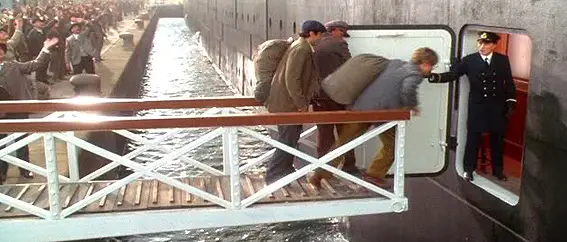
Moody is portrayed in the 1997 film "Titanic" as admitting last minute fictional characters at the aft gangway. In reality, Moody actually denied a group of late stokers and trimmers who had been drinking from boarding.
Once at sea, Moody settled in to his duties as Titanic's Sixth Officer. According to Fourth officer Boxhall one of those duties included taking a report of the water and air temperature every two hours: "The sailor men and the quartermaster took this temperature, and I would see them doing it, sometimes… It was reported to the junior officer... Mr. Moody... it was the junior officer’s duty to see that the log did contain it." (US Inquiry)
Third Officer Pitman also noted Moody's responsibility in regards to the ship's log: "The scrap log is kept on the bridge; the fifth and sixth look after that. The chief officer’s log is copied from that... The fifth and sixth keep the scrap log, as everything happens on the bridge, alterations of courses, deviations, and that sort of thing, and it is copied from there into the chief officer's log, which is really the official log." (US Inquiry)
Dog Watch Ice Report
Moody, along with Fourth officer Boxhall, had the first 'dog watch' (half watch) - from 4pm - 6pm on the Sunday and it is possibly during this watch that Moody put a mark on the chart with reference to an ice message received. Third officer Pitman later testified: "As far as I can remember, one was put on the chart between 4 and 6.. it was either Mr. Boxhall or Mr. Moody. Mr. Boxhall does not seem to have any recollection of it, so it must have been Mr. Moody... I saw it there when I came on deck at 6 p.m. (British Inquiry)